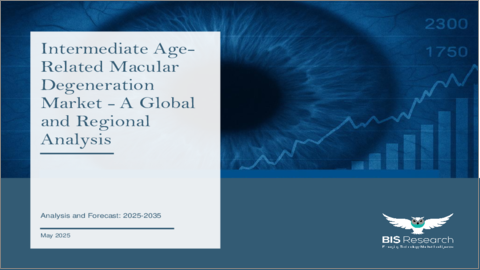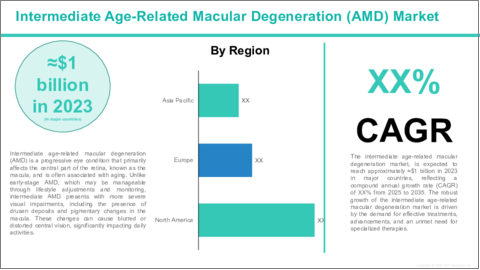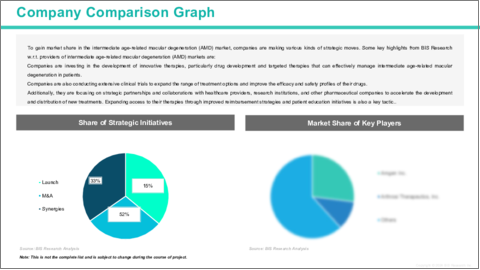|
|
市場調査レポート
商品コード
1737974
中間期加齢黄斑変性の世界市場:地域別の分析・予測 (2025-2035年)Intermediate Age-Related Macular Degeneration Market - A Global and Regional Analysis: Analysis and Forecast, 2025-2035 |
||||||
カスタマイズ可能
|
|||||||
| 中間期加齢黄斑変性の世界市場:地域別の分析・予測 (2025-2035年) |
|
出版日: 2025年05月30日
発行: BIS Research
ページ情報: 英文 100 Pages
納期: 1~5営業日
|
全表示
- 概要
- 図表
- 目次
中間期加齢黄斑変性は、50歳以上の人に多く見られる進行性の網膜疾患であり、特に高齢者において視覚障害の主要な原因の一つとされています。
中間期加齢黄斑変性の有病率の増加と世界的な高齢化の進行は、本市場の主要な成長要因となっています。年齢に加え、遺伝的要因、喫煙、長時間の紫外線曝露なども発症リスクを高める要因として挙げられています。今後も高齢者人口が増加する中で、有効な治療法や診断ツールに対する需要はさらに高まると予測されており、市場拡大が期待されています。
加齢黄斑変性市場における重要な進展として、抗VEGF療法の使用拡大が挙げられます。これらの治療法は、滲出型の加齢黄斑変性の進行を抑制する効果が大きく実証されており、中間期加齢黄斑変性に対しても適用可能性が研究されている段階です。将来的には、重症化を防ぐ手段として抗VEGF療法が活用されることが期待されています。また、細胞治療や遺伝子治療、その他の革新的な治療薬候補の登場も市場の拡大に寄与しています。
薬物療法に加えて、光干渉断層計(OCT)や眼底自発蛍光(FAF)といった先進的な画像診断技術の活用が、中間期AMDの診断および経過観察を大きく変革しています。これらの技術は、網膜の層構造を詳細に観察することを可能にし、視力低下が進行する前に疾患の兆候を早期に捉えることができます。さらに、AIをOCTやFAF画像の解析に統合することで、診断精度が向上し、疾患の進行予測や個別化された治療計画の立案がより効果的に行えるようになっています。
さらに、中間期加齢黄斑変性による機能的な制限に対処するための視覚リハビリテーションサービスへの需要も高まっています。これらのサービスは、残存視力の最大活用や生活の質の向上に焦点を当てており、市場成長の一因となっています。研究開発の進展に伴い、中間期加齢黄斑変性市場の将来には、より標的を絞った治療法や高度な診断ツールの実用化が期待されており、今後も市場の拡大が続くと見込まれています。
当レポートでは、世界の中間期加齢黄斑変性の市場を調査し、主要動向、市場影響因子の分析、法規制環境、臨床試験の動向、市場規模の推移・予測、各種区分・地域/主要国別の詳細分析、競合情勢、主要企業のプロファイルなどをまとめています。
目次
エグゼクティブサマリー
第1章 世界の中間期加齢黄斑変性市場:業界の展望
- 市場動向
- 規制の枠組み
- 中間期加齢黄斑変性の疫学
- 臨床試験の分析
- 市場力学
- 影響分析
- 市場促進要因
- 市場の課題
- 市場機会
第2章 世界の中間期加齢黄斑変性市場:地域別
- 北米
- 欧州
- アジア太平洋
- 主な調査結果
- 市場力学
- 市場規模・予測
第3章 世界の中間期加齢黄斑変性市場:競合情勢と企業プロファイル
- 主な展開・戦略
- M&A
- 相乗的な取り組み
- 事業拡大と資金調達
- 製品の発売と承認
- その他の活動
- 企業プロファイル
- Novartis AG
- Allegro Ophthalmics, LLC.
- Apellis Pharmaceuticals
第4章 調査手法
List of Figures
- Figure: Global Intermediate Age-Related Macular Degeneration Market (by Region), $Million, 2024 and 2035
- Figure: Epidemiology of Intermediate Age-Related Macular Degeneration
- Figure: Global Intermediate Age-Related Macular Degeneration Market Coverage
- Figure: Global Intermediate Age-Related Macular Degeneration Market Key Trends, Impact Analysis, 2023-2035
- Figure: Global Intermediate Age-Related Macular Degeneration Market, Competitive Landscape, January 2022-April 2025
List of Tables
- Table: Global Intermediate Age-Related Macular Degeneration Market, Clinical Trial Analysis
- Table: Global Intermediate Age-Related Macular Degeneration Market Dynamics, Impact Analysis
- Table: Global Intermediate Age-Related Macular Degeneration Market (by Region), $Million, 2023-2035
Global Intermediate Age-Related Macular Degeneration Market, Analysis and Forecast: 2025-2035
Intermediate age-related macular degeneration is a progressive retinal condition that typically affects individuals aged 50 and older. It is a major cause of vision impairment, particularly in the aging population. The growing prevalence of intermediate age-related macular degeneration, coupled with an aging global population, is a key driver of the market. In addition to aging, risk factors such as genetics, smoking, and prolonged exposure to sunlight contribute to the disease's increasing incidence. As the population continues to age, the demand for effective treatments and diagnostic tools for intermediate age-related macular degeneration is expected to grow, driving market expansion.
A critical development in the age-related macular degeneration market is the increasing use of anti-VEGF (vascular endothelial growth factor) therapies. These treatments have shown significant efficacy in slowing the progression of wet age-related macular degeneration, and while their use in intermediate age-related macular degeneration is still under investigation, they are expected to play a role in preventing the advancement to more severe stages. The growing availability of novel therapies, including cell and gene therapies and other innovative drug candidates, is also contributing to the market's expansion.
In addition to pharmacological treatments, the use of advanced imaging technologies such as optical coherence tomography (OCT) and fundus autofluorescence (FAF) is revolutionizing the diagnosis and monitoring of intermediate age-related macular degeneration. These imaging tools allow for a detailed examination of the retinal layers, enabling early detection of disease progression before significant vision loss occurs. The integration of artificial intelligence (AI) in the analysis of OCT and FAF images further enhances diagnostic precision, offering clinicians tools to predict disease progression and tailor treatment plans more effectively.
Moreover, the demand for vision rehabilitation services is rising as a means to help patients cope with the functional limitations imposed by intermediate age-related macular degeneration. These therapies, which focus on maximizing remaining vision and improving quality of life, are contributing to the market's growth. As research advances, the future of the intermediate age-related macular degeneration market holds promise for more targeted therapies and improved diagnostic tools, driving overall market expansion.
Despite the positive growth trajectory, several challenges continue to impact the global intermediate age-related macular degeneration market. One of the primary challenges is the high cost of advanced treatments, particularly anti-VEGF (vascular endothelial growth factor) injections, represents a significant financial challenge for both patients and healthcare systems. Anti-VEGF therapies are used to treat a variety of retinal diseases, such as age-related macular degeneration, diabetic retinopathy, and retinal vein occlusion. These treatments aim to inhibit the growth of abnormal blood vessels in the retina, which can lead to vision loss if left untreated.
Moreover, the side effects of current therapies may pose a major barrier to market growth, one of the most common risks associated with anti-VEGF injections is eye infections, such as endophthalmitis. This condition, although rare, can lead to severe complications, including vision loss. The risk of infection is especially concerning since the injections involve introducing medication directly into the eye, making it an invasive procedure.
As the global intermediate age-related macular degeneration market continues to grow, key trends such as advancements in early diagnostic technologies, the development of novel therapeutic approaches, and the increasing use of personalized treatments are expected to drive market expansion. The rising aging population and the growing awareness of the condition's impact on vision health are contributing to the higher demand for effective age-related macular degeneration treatments. Innovations in drug delivery systems, such as sustained-release intravitreal implants, and the increasing adoption of minimally invasive therapies are expected to enhance treatment outcomes and patient satisfaction. Additionally, research into genetic and environmental factors is paving the way for more tailored therapeutic options.
In conclusion, the global intermediate age-related macular degeneration market is set for robust growth, fueled by technological innovations in diagnostics and treatment, a rising aging demographic, and a growing focus on improving vision health. As healthcare providers and researchers continue to develop more effective and personalized therapies, there will be substantial opportunities for both new and established market players to address the unmet needs of age-related macular degeneration patients, ultimately improving patient outcomes and quality of life.
Table of Contents
Executive Summary
Scope and Definition
Market/Product Definition
Inclusion and Exclusion
Key Questions Answered
Analysis and Forecast Note
1. Global Intermediate Age-Related Macular Degeneration Market: Industry Outlook
- 1.1 Introduction
- 1.2 Market Trends
- 1.3 Regulatory Framework
- 1.4 Epidemiology of Intermediate Age-Related Macular Degeneration
- 1.5 Clinical Trial Analysis
- 1.6 Market Dynamics
- 1.6.1 Impact Analysis
- 1.6.2 Market Drivers
- 1.6.3 Market Challenges
- 1.6.4 Market Opportunities
2. Global Intermediate Age-Related Macular Degeneration Market, by Region, $Million, 2023-2035
- 2.1 North America
- 2.1.1 Key Findings
- 2.1.2 Market Dynamics
- 2.1.3 Market Sizing and Forecast
- 2.1.3.1 North America Intermediate Age-Related Macular Degeneration Market, by Country
- 2.1.3.1.1 U.S.
- 2.1.3.1 North America Intermediate Age-Related Macular Degeneration Market, by Country
- 2.2 Europe
- 2.2.1 Key Findings
- 2.2.2 Market Dynamics
- 2.2.3 Market Sizing and Forecast
- 2.2.3.1 Europe Intermediate Age-Related Macular Degeneration Market, by Country
- 2.2.3.1.1 Germany
- 2.2.3.1.2 U.K.
- 2.2.3.1.3 France
- 2.2.3.1.4 Italy
- 2.2.3.1.5 Spain
- 2.2.3.1 Europe Intermediate Age-Related Macular Degeneration Market, by Country
- 2.3 Asia Pacific
- 2.3.1 Key Findings
- 2.3.2 Market Dynamics
- 2.3.3 Market Sizing and Forecast
- 2.3.3.1 Asia Pacific Intermediate Age-Related Macular Degeneration Market, by Country
- 2.3.3.1.1 Japan
- 2.3.3.1 Asia Pacific Intermediate Age-Related Macular Degeneration Market, by Country
3. Global Intermediate Age-Related Macular Degeneration Market: Competitive Landscape and Company Profiles
- 3.1 Key Developments and Strategies
- 3.1.1 Mergers and Acquisitions
- 3.1.2 Synergistic Activities
- 3.1.3 Business Expansions and Funding
- 3.1.4 Product Launches and Approvals
- 3.1.5 Other Activities
- 3.2 Company Profiles
- 3.2.1 Novartis AG
- 3.2.1.1 Overview
- 3.2.1.2 Top Products / Product Portfolio
- 3.2.1.3 Target Customers/End-Users
- 3.2.1.4 Key Personnel
- 3.2.1.5 Analyst View
- 3.2.2 Allegro Ophthalmics, LLC.
- 3.2.2.1 Overview
- 3.2.2.2 Top Products / Product Portfolio
- 3.2.2.3 Target Customers/End-Users
- 3.2.2.4 Key Personnel
- 3.2.2.5 Analyst View
- 3.2.3 Apellis Pharmaceuticals
- 3.2.3.1 Overview
- 3.2.3.2 Top Products / Product Portfolio
- 3.2.3.3 Target Customers/End-Users
- 3.2.3.4 Key Personnel
- 3.2.3.5 Analyst View
- 3.2.1 Novartis AG





